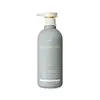What's inside
What's inside
 Key Ingredients
Key Ingredients

No key ingredients
 Benefits
Benefits

No benefits
 Concerns
Concerns

 Ingredients Side-by-side
Ingredients Side-by-side

Zinc Pyrithione 1%
AntiseborrhoeicWater
Skin ConditioningSodium Lauryl Sulfate
CleansingSodium Laureth Sulfate
CleansingGlycol Distearate
EmollientZinc Carbonate
Sodium Chloride
MaskingSodium Xylenesulfonate
Cocamidopropyl Betaine
CleansingParfum
MaskingDimethicone
EmollientSodium Benzoate
MaskingGuar Hydroxypropyltrimonium Chloride
Skin ConditioningMagnesium Carbonate Hydroxide
BufferingMethylchloroisothiazolinone
PreservativeMethylisothiazolinone
PreservativeBlue 1 Lake
Cosmetic ColorantCI 17200
Cosmetic ColorantZinc Pyrithione 1%, Water, Sodium Lauryl Sulfate, Sodium Laureth Sulfate, Glycol Distearate, Zinc Carbonate, Sodium Chloride, Sodium Xylenesulfonate, Cocamidopropyl Betaine, Parfum, Dimethicone, Sodium Benzoate, Guar Hydroxypropyltrimonium Chloride, Magnesium Carbonate Hydroxide, Methylchloroisothiazolinone, Methylisothiazolinone, Blue 1 Lake, CI 17200
Water
Skin ConditioningSodium C14-16 Olefin Sulfonate
CleansingCocamidopropyl Betaine
CleansingLauryl Glucoside
CleansingGlycerin
HumectantLauramide DEA
PPG-3 Caprylyl Ether
SolventTetradecene
EmollientHexadecene
SolventSodium Sulfate
Sodium Chloride
MaskingHydrolyzed Keratin
HumectantPentylene Glycol
Skin ConditioningHydrolyzed Wheat Protein
Skin ConditioningPanthenol
Skin ConditioningButylene Glycol
HumectantGlycyrrhiza Glabra Root Extract
BleachingAngelica Gigas Root Extract
Skin ConditioningPolygonum Multiflorum Root Extract
Skin ConditioningCamellia Sinensis Leaf Extract
AntimicrobialPanax Ginseng Root Extract
EmollientPortulaca Oleracea Extract
Skin ConditioningRheum Palmatum Root Extract
AstringentBletilla Striata Root Extract
Skin ConditioningCarthamus Tinctorius Flower Extract
Skin ConditioningSilkworm Extract
Skin Conditioning1,2-Hexanediol
Skin ConditioningHydroxyacetophenone
AntioxidantClimbazole
AntimicrobialSalicylic Acid
MaskingMenthol
MaskingCitric Acid
BufferingDimethyl Sulfone
SolventAllantoin
Skin ConditioningPolyquaternium-10
Betaine
HumectantDisodium EDTA
Parfum
MaskingLimonene
PerfumingLinalool
PerfumingCitronellol
PerfumingHexyl Cinnamal
PerfumingWater, Sodium C14-16 Olefin Sulfonate, Cocamidopropyl Betaine, Lauryl Glucoside, Glycerin, Lauramide DEA, PPG-3 Caprylyl Ether, Tetradecene, Hexadecene, Sodium Sulfate, Sodium Chloride, Hydrolyzed Keratin, Pentylene Glycol, Hydrolyzed Wheat Protein, Panthenol, Butylene Glycol, Glycyrrhiza Glabra Root Extract, Angelica Gigas Root Extract, Polygonum Multiflorum Root Extract, Camellia Sinensis Leaf Extract, Panax Ginseng Root Extract, Portulaca Oleracea Extract, Rheum Palmatum Root Extract, Bletilla Striata Root Extract, Carthamus Tinctorius Flower Extract, Silkworm Extract, 1,2-Hexanediol, Hydroxyacetophenone, Climbazole, Salicylic Acid, Menthol, Citric Acid, Dimethyl Sulfone, Allantoin, Polyquaternium-10, Betaine, Disodium EDTA, Parfum, Limonene, Linalool, Citronellol, Hexyl Cinnamal
 Reviews
Reviews

Ingredients Explained
These ingredients are found in both products.
Ingredients higher up in an ingredient list are typically present in a larger amount.
Cocamidopropyl Betaine is a fatty acid created by mixing similar compounds in coconut oil and dimethylaminopropylamine, a compound with two amino groups.
This ingredient is a surfactant and cleanser. It helps gather the dirt, pollutants, and other impurities in your skin to be washed away. It also helps thicken a product and make the texture more creamy.
Being created from coconut oil means Cocamidopropyl Betaine is hydrating for the skin.
While Cocamidopropyl Betaine was believed to be an allergen, a study from 2012 disproved this. It found two compounds in unpure Cocamidopropyl Betaine to be the irritants: aminoamide and 3-dimethylaminopropylamine. High-grade and pure Cocamidopropyl Betaine did not induce allergic reactions during this study.
Learn more about Cocamidopropyl BetaineParfum is a catch-all term for an ingredient or more that is used to give a scent to products.
Also called "fragrance", this ingredient can be a blend of hundreds of chemicals or plant oils. This means every product with "fragrance" or "parfum" in the ingredients list is a different mixture.
For instance, Habanolide is a proprietary trade name for a specific aroma chemical. When used as a fragrance ingredient in cosmetics, most aroma chemicals fall under the broad labeling category of “FRAGRANCE” or “PARFUM” according to EU and US regulations.
The term 'parfum' or 'fragrance' is not regulated in many countries. In many cases, it is up to the brand to define this term.
For instance, many brands choose to label themselves as "fragrance-free" because they are not using synthetic fragrances. However, their products may still contain ingredients such as essential oils that are considered a fragrance by INCI standards.
One example is Calendula flower extract. Calendula is an essential oil that still imparts a scent or 'fragrance'.
Depending on the blend, the ingredients in the mixture can cause allergies and sensitivities on the skin. Some ingredients that are known EU allergens include linalool and citronellol.
Parfum can also be used to mask or cover an unpleasant scent.
The bottom line is: not all fragrances/parfum/ingredients are created equally. If you are worried about fragrances, we recommend taking a closer look at an ingredient. And of course, we always recommend speaking with a professional.
Learn more about ParfumChances are, you eat sodium chloride every day. Sodium Chloride is also known as table salt.
This ingredient has many purposes in skincare: thickener, emulsifier, and exfoliator.
You'll most likely find this ingredient in cleansers where it is used to create a gel-like texture. As an emulsifier, it also prevents ingredients from separating.
There is much debate on whether this ingredient is comedogenic. The short answer - comedogenic ratings don't tell the whole story. Learn more about comegodenic ratings here.
The concensus about this ingredient causing acne seems to be divided. Research is needed to understand if this ingredient does cause acne.
Scrubs may use salt as the primary exfoliating ingredient.
Learn more about Sodium ChlorideWater. It's the most common cosmetic ingredient of all. You'll usually see it at the top of ingredient lists, meaning that it makes up the largest part of the product.
So why is it so popular? Water most often acts as a solvent - this means that it helps dissolve other ingredients into the formulation.
You'll also recognize water as that liquid we all need to stay alive. If you see this, drink a glass of water. Stay hydrated!
Learn more about Water